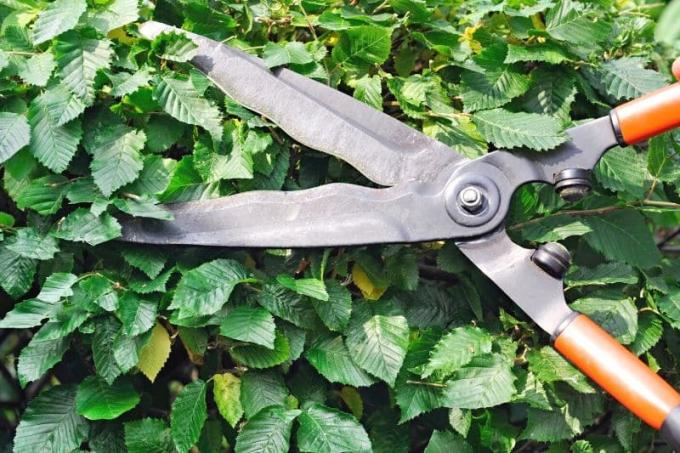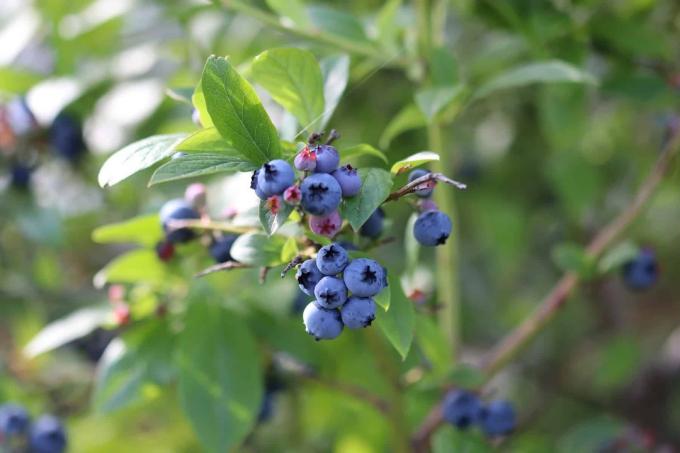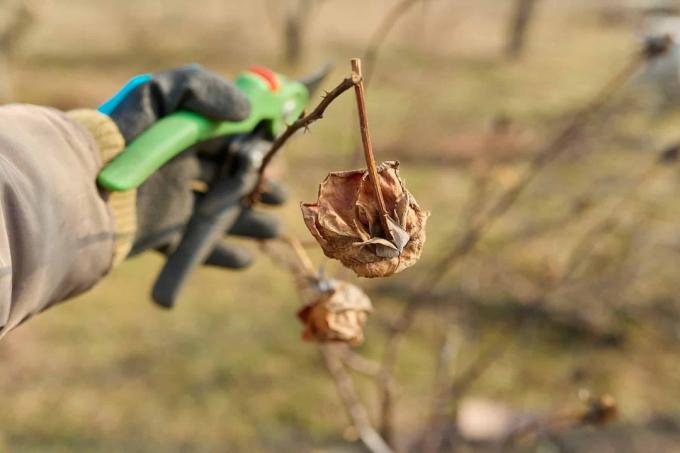
When it comes to pruning trees, experts have different opinions. Early spring is ideal, but you can also cut various shrubs in autumn. Everything you need to know about this can be found in this post.
In a nutshell
- do not cut all shrubs in the fall
- Berry fruit bushes tolerate autumn pruning
- Note differences when cutting white/red and black currants
- Cut ornamental shrubs and hedge shrubs into shape in autumn
- always use sharp cutting tools
Table of contents
- Ornamental shrubs and Co.
- hedge shrubs
- berry fruit bushes
- currants
- gooseberries
- blueberries
- blackberries
- summer raspberries
- autumn raspberries
- frequently asked Questions
Ornamental shrubs and Co.
In autumn you can cut most deciduous ornamental shrubs, various evergreen shrubs and conifers. These include, among others:
- boxwood (Buxus sempervirens)
- yew (taxus baccata)
- Fingerbush (Potentilla fructiosa)
- Golden currant (Ribes aureum)
- hazelnut bush (Corylus avellana)
- tree of life (thuja)
- Almond bush/almond trees (Prunus triloba)
- Smoke Tree (Cotinus coggygria)
- Sea Buckthorn (Hippophae rhamnoides)
- sack flower (Ceanothus)
- Holly (Ilex aquifolium)
- Cypress (Cupressus)

The shrubs are cut as follows
- Cut back far when growing vigorously
- remove diseased, dead, weak and cross-growing shoots
- Trim sides and height too
- if the branches are too close together, cut off the weakest at the base
- thin out below
- cut out two or three woody, thick shoots
- Cut off existing wilted flowers down to a leaf, leaf node or bud
A notice: Note that according to lawmakers to protect breeding birds, shrubs and trees may only be cut back in the period between October and March.
hedge shrubs

Also hedge plants like hornbeam (Carpinus betulus), liguster (Ligustrum vulgare), Firethorn (Pyracantha) or Barberry (Berberis vulgaris) tolerate pruning in autumn. They can be cut into shape, rejuvenation of the bushes is also possible:
- Cut away broken and kinked branches
- trim any overhanging branches
- lower hedge area must be wider than upper one
- this allows more light into the interior of the hedge
- Hedge shrubs grow denser and more compact
- for rejuvenation, shorten all main branches to 30 cm
A notice: Larger interfaces are portals of entry for pathogens. Therefore, seal them with a wound protection paste.
berry fruit bushes
To at soft fruit To ensure a good yield the following year, you should prune the shrubs after harvest, at the end of August/beginning of September and even later in the autumn if the weather is mild. However, there are a few things to consider:
currants

The cutback of the individual varieties is different. It should be noted that white and red currants (Ribes) on three-year-old wood and black currants on one- to two-year-old wood.
White and Red Currants
- Remove at least two to three four-year-old shoots close to the ground every year
- Cut out all one-year-old shoots close to the ground except for two or three
- leave no butts
- Shorten all side shoots in the lower part of the bush to 30 to 40 cm
- Cut off the harvested side shoots of the older leading shoots to a centimeter
- Cut is made over the outwardly standing eye
- remove dead, weak, transversely growing shoots
Black Currants
- remove all weak shoots on main branches and base
- Cut out older shoots close to the ground
- also cut off dead and crossing shoots at the base
- Shorten all other shoots above the second or third side shoot
- leave all strong new shoots
A notice: Old shoots can be recognized by their dark bark and larger girth. Young shoots are light green in color.
gooseberries

Gooseberries (Ribes uva-crispa) bear fruit on wood that is one to three years old. So cut the shrubs correctly:
- Shorten the six to eight longest shoots by a third
- eight strong main shoots - leave two one-year-old, two-year-old, three-year-old, four-year-old
- remove all remaining shoots close to the ground
blueberries

blueberries (Vaccinium) should be cut back regularly from the fourth year. Prune the shrubs in late fall when they are no longer in leaf. The largest fruits always appear on one-year-old wood, so the shrubs should be rejuvenated by thinning out:
- Cut back the removed shoot tips
- Removal of the old branches close to the ground
- recognizable by the woody, grey-brown bark
- only leave 5 to 8 green, young shoots
- remove all cross growing and crossing branches
blackberries

Blackberry bushes (Rubus fructicosus) bear fruit only on two-year-old wood. A cutback is possible in late autumn or in winter. Proceed as follows:
- remove all worn rods to ground level
- shorten very long young shoots
- this leads to the development of strong side shoots
- attach to trellis
A notice: The cutting tool for any pruning must be sharp and sanitized. It consists of good pruning shears, hedge shears, folding saw and telescopic scissors.
summer raspberries

Flowers and fruits appear at this raspberry variety (Rubus idaeus) only on two-year-old wood. However, the flower buds are already created in the autumn of the previous year.
- remove all worn rods close to the ground
- of young shoots only leave six to eight shoots per meter
- Attach shoots to trellis
- Cut off the remaining young shoots close to the ground
autumn raspberries
Flowers and fruits are formed on the new shoots of these raspberries in the same year. The harvest then takes place from August to September.
- Cut back after harvest in October
- Cut off all shoots close to the ground
- shoots that have remained will bear fruit early in the following year
- But fruits are small and few

A notice:Roses do not necessarily have to be pruned in autumn. Only remove old flowers and seeds. In addition, old tendrils protect the young shoots from frost.
frequently asked Questions
The spring bloomers under the shrubs must not be cut in the fall. They bloom on annual and perennial shoots. The flower buds are already created in autumn of the previous year. These trees are pruned every three years after flowering. These include, among other things forsythia (Forsythia), Deutzia (Deutzia), weigela (Weigelia), double snowball (Viburnum opulus "Roseum"), spice bush (Calycanthus floridus), lilac (Syringa vulgaris), honeysuckle (Lonicera) and spirea (Spiraea).
Fall pruning comes with a number of benefits. This will prevent the spread of diseases and pests. Diseased, dead shoots and branches are clearly visible and removal is easier. Pruning in the fall gives the shrubs a head start in the spring. Budding is earlier and bushier. In addition, branch damage caused by heavy snow loads can be avoided by pruning in autumn.
The best time for cutting is between the end of September and the beginning of November, when the cuts can heal until winter. The temperature should be above five degrees Celsius. A dry, cloudy day is best chosen. The pruning must not be carried out in strong sunlight, otherwise the interfaces will dry out.
Larger quantities can usually be handed in free of charge at the municipal recycling depots. There is also the option of making the cut too chop or to shred and then use to cover beds and mulch plants. It is essential to ensure that the clippings are free of pests and diseases.
